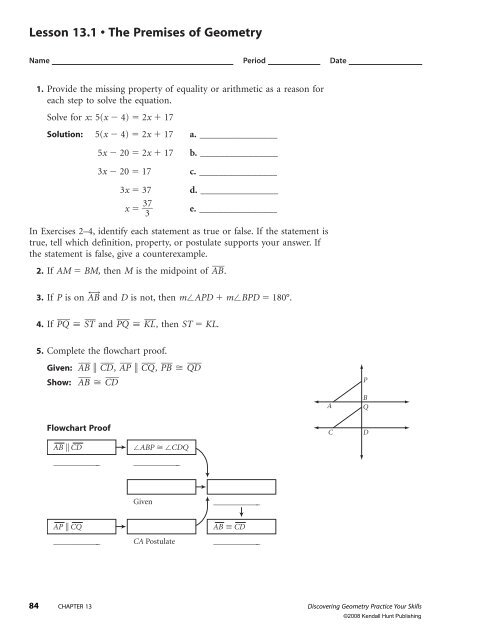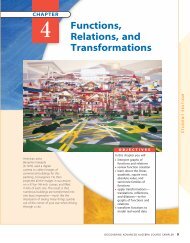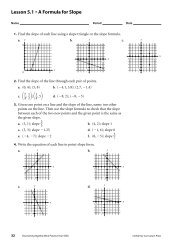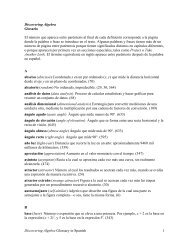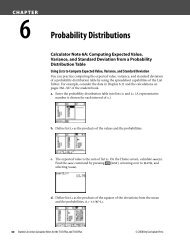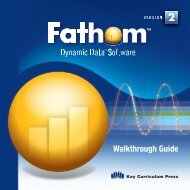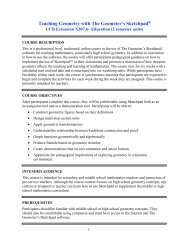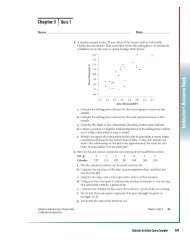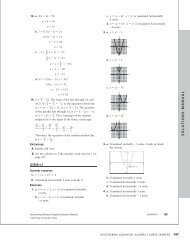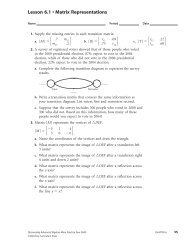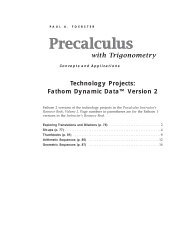Chapter 13 (PDF)
Chapter 13 (PDF)
Chapter 13 (PDF)
Create successful ePaper yourself
Turn your PDF publications into a flip-book with our unique Google optimized e-Paper software.
Lesson <strong>13</strong>.1 • The Premises of Geometry<br />
Name Period Date<br />
1. Provide the missing property of equality or arithmetic as a reason for<br />
each step to solve the equation.<br />
Solve for x: 5(x 4) 2x 17<br />
Solution: 5(x 4) 2x 17 a. ________________<br />
5x 20 2x 17 b. ________________<br />
3x 20 17 c. ________________<br />
3x 37 d. ________________<br />
x 37<br />
<br />
3<br />
e. ________________<br />
In Exercises 2–4, identify each statement as true or false. If the statement is<br />
true, tell which definition, property, or postulate supports your answer. If<br />
the statement is false, give a counterexample.<br />
2. If AM BM, then M is the midpoint of AB.<br />
3. If P is on AB and D is not, then mAPD mBPD 180°.<br />
4. If PQ ST and PQ KL, then ST KL.<br />
5. Complete the flowchart proof.<br />
Given: AB CD , AP CQ , PB QD <br />
Show: AB CD <br />
Flowchart Proof<br />
AB CD<br />
ABP CDQ<br />
____________ ____________<br />
AP CQ<br />
Given<br />
____________<br />
AB CD<br />
____________ CA Postulate<br />
____________<br />
P<br />
B<br />
A Q<br />
84 CHAPTER <strong>13</strong> Discovering Geometry Practice Your Skills<br />
C<br />
D<br />
©2008 Kendall Hunt Publishing
Lesson <strong>13</strong>.2 • Planning a Geometry Proof<br />
Name Period Date<br />
For these exercises, you may use theorems added to your theorem list<br />
through the end of Lesson <strong>13</strong>.2.<br />
In Exercises 1–3, write a paragraph proof or a flowchart proof for<br />
each situation.<br />
1. Given: AB CD , AP CQ <br />
P<br />
Show: PAB QCD<br />
2. Given: PQ ST, QPR STU<br />
Show: PR UT<br />
3. Given: Noncongruent, nonparallel<br />
segments AB, BC, and AC<br />
Show: x y z 180°<br />
P<br />
Q<br />
R<br />
x A<br />
a<br />
U<br />
b c<br />
y B<br />
C z<br />
Discovering Geometry Practice Your Skills CHAPTER <strong>13</strong> 85<br />
©2008 Kendall Hunt Publishing<br />
A<br />
B<br />
C<br />
Q<br />
S<br />
T<br />
D
Lesson <strong>13</strong>.3 • Triangle Proofs<br />
Name Period Date<br />
Write a proof for each situation. You may use theorems added to your<br />
theorem list through the end of Lesson <strong>13</strong>.3.<br />
1. Given: XY ZY, XZ WY W<br />
2. Given: CD AC, BD AB, CD BD<br />
Show: WXY WZY Show: ABD ACD<br />
M<br />
X Z<br />
3. Given: MN QM , NO QM , 4. Given: AB BC, ACB ECD,<br />
P is the midpoint of MO R<br />
AB BD<br />
Show: QMN RON<br />
O<br />
Show: BD CE<br />
B<br />
E<br />
N<br />
Y<br />
P<br />
M<br />
Q<br />
86 CHAPTER <strong>13</strong> Discovering Geometry Practice Your Skills<br />
A<br />
A<br />
C<br />
C<br />
D<br />
B<br />
D<br />
©2008 Kendall Hunt Publishing
Lesson <strong>13</strong>.4 • Quadrilateral Proofs<br />
Name Period Date<br />
In Exercises 1–6, write a proof of each conjecture on a separate piece of<br />
paper. You may use theorems added to your theorem list through the end<br />
of Lesson <strong>13</strong>.4.<br />
1. The diagonals of a parallelogram bisect each other. (Parallelogram<br />
Diagonals Theorem)<br />
2. If the diagonals of a quadrilateral bisect each other, then the<br />
quadrilateral is a parallelogram. (Converse of the Parallelogram<br />
Diagonals Theorem)<br />
3. The diagonals of a rhombus bisect each other and are perpendicular.<br />
(Rhombus Diagonals Theorem)<br />
4. If the diagonals of a quadrilateral bisect each other and are<br />
perpendicular, then the quadrilateral is a rhombus. (Converse of the<br />
Rhombus Diagonals Theorem)<br />
5. If the base angles on one base of a trapezoid are congruent, then the<br />
trapezoid is isosceles. (Converse of the Isosceles Trapezoid Theorem)<br />
6. If the diagonals of a trapezoid are congruent, then the trapezoid is<br />
isosceles. (Converse of the Isosceles Trapezoid Diagonals Theorem)<br />
In Exercises 7–9, decide if the statement is true or false. If it is true, prove<br />
it. If it is false, give a counterexample.<br />
7. A quadrilateral with one pair of parallel sides and one pair of<br />
congruent angles is a parallelogram.<br />
8. A quadrilateral with one pair of congruent opposite sides and one pair<br />
of parallel sides is a parallelogram.<br />
9. A quadrilateral with one pair of parallel sides and one pair of<br />
congruent opposite angles is a parallelogram.<br />
Discovering Geometry Practice Your Skills CHAPTER <strong>13</strong> 87<br />
©2008 Kendall Hunt Publishing
Lesson <strong>13</strong>.5 • Indirect Proof<br />
Name Period Date<br />
1. Complete the indirect proof of the conjecture: In a triangle the side<br />
opposite the larger of two angles has a greater measure.<br />
Given: ABC with mA mB<br />
Show: BC AC<br />
Proof: Assume ________________<br />
Case 1: BC AC<br />
If BC AC, then ABC is ________________ by _______________.<br />
By _______________, A B, which contradicts ______________.<br />
So, BC AC.<br />
Case 2: BC AC<br />
If BC AC, then it is possible to construct point D on CA such that<br />
CD CB, by the Segment Duplication Postulate. Construct DB, by<br />
the Line Postulate. DBC is ________________. Complete the proof.<br />
A<br />
D 4<br />
1<br />
C<br />
2<br />
3<br />
B<br />
In Exercises 2–5, write an indirect proof of each conjecture.<br />
2. Given: AD AB, DC BC<br />
A<br />
Show: DAC BAC<br />
3. If two sides of a triangle are not congruent, then the angles<br />
opposite them are not congruent.<br />
4. If two lines are parallel and a third line in the same plane intersects<br />
one of them, then it also intersects the other.<br />
B<br />
88 CHAPTER <strong>13</strong> Discovering Geometry Practice Your Skills<br />
A<br />
C<br />
C<br />
D<br />
B<br />
©2008 Kendall Hunt Publishing
Lesson <strong>13</strong>.6 • Circle Proofs<br />
Name Period Date<br />
Write a proof for each conjecture or situation. You may use theorems<br />
added to your theorem list through the end of Lesson <strong>13</strong>.6.<br />
1. If two chords in a circle are congruent, then their arcs are congruent.<br />
2. Given: Regular pentagon ABCDE inscribed in circle O, with diagonals<br />
AC and AD <br />
Show: AC and AD trisect BAE<br />
3. Given: Two circles externally tangent at R, common external tangent<br />
segment TS<br />
Show: TRS is a right angle<br />
4. Given: Two circles internally tangent at T with chords TD<br />
and TB of the larger circle intersecting the smaller<br />
circle at C and A<br />
Show: AC BD<br />
D<br />
B<br />
E D<br />
Discovering Geometry Practice Your Skills CHAPTER <strong>13</strong> 89<br />
©2008 Kendall Hunt Publishing<br />
A<br />
C<br />
A<br />
T<br />
B<br />
O<br />
R<br />
T<br />
C<br />
S
Lesson <strong>13</strong>.7 • Similarity Proofs<br />
Name Period Date<br />
Write a proof for each situation. You may use theorems added to your<br />
theorem list through the end of Lesson <strong>13</strong>.7.<br />
1. Given: ABC with A BCD<br />
Show: BC 2 AB BD<br />
2. The diagonals of a trapezoid divide each other into segments with<br />
lengths in the same ratio as the lengths of the bases.<br />
3. In a right triangle the product of the lengths of the two legs equals the<br />
product of the lengths of the hypotenuse and the altitude to the<br />
hypotenuse.<br />
4. If a quadrilateral has one pair of opposite right angles and one pair of<br />
opposite congruent sides, then the quadrilateral is a rectangle.<br />
A<br />
90 CHAPTER <strong>13</strong> Discovering Geometry Practice Your Skills<br />
C<br />
D<br />
B<br />
©2008 Kendall Hunt Publishing
7. RS 22.5 cm, EB 20 cm<br />
8. x 20 cm; y 7.2 cm<br />
9. p 16<br />
<br />
3<br />
5.3 cm; q 8<br />
3 2.6 cm<br />
LESSON 12.1 • Trigonometric Ratios<br />
1. sin P p<br />
<br />
r<br />
2. cos P q<br />
r <br />
3. tan P p<br />
<br />
q<br />
4. sin Q q<br />
r <br />
5. sin T 0.800 6. cos T 0.600<br />
7. tan T 1.333 8. sin R 0.600<br />
9. x 12.27 10. x 29.75<br />
11. x 18.28 12. mA 71°<br />
<strong>13</strong>. mB 53° 14. mC 30°<br />
w<br />
15. sin 40° ; 28<br />
w 18.0 cm<br />
x<br />
16. sin 28° ; 14<br />
x 7.4 cm<br />
17. cos 17° 7 y 3 ; y 76.3 cm<br />
18. a 28° 19. t 47° 20. z 76°<br />
LESSON 12.2 • Problem Solving with Right Triangles<br />
1. Area 2 cm 2 2. Area 325 ft 2<br />
3. Area 109 in 2 4. x 54.0°<br />
5. y 31.3° 6. a 7.6 in.<br />
7. Diameter 20.5 cm 8. 45.2°<br />
9. 28.3° 10. About 2.0 m<br />
11. About 445.2 ft 12. About 22.6 ft<br />
LESSON 12.3 • The Law of Sines<br />
1. Area 46 cm 2 2. Area 24 m 2 3. Area 45 ft 2<br />
4. m 14 cm 5. p 17 cm 6. q <strong>13</strong> cm<br />
7. mB 66°, mC 33°<br />
8. mP 37°, mQ 95°<br />
9. mK 81°, mM 21°<br />
10. Second line: about 153 ft, between tethers: about <strong>13</strong>5 ft<br />
LESSON 12.4 • The Law of Cosines<br />
1. t <strong>13</strong> cm 2. b 67 cm<br />
3. w 34 cm<br />
4. mA 76°, mB 45°, mC 59°<br />
5. mA 77°, mP 66°, mS 37°<br />
6. mS 46°, mU 85°, mV 49°<br />
7. About 24° 8. About 43.0 cm<br />
9. About 34.7 in.<br />
LESSON 12.5 • Problem Solving with Trigonometry<br />
1. About 2.85 mi/h; about 15°<br />
2. mA 50.64°, mB 59.70°, mC 69.66°<br />
3. About 8.0 km from Tower 1, 5.1 km from Tower 2<br />
4. About 853 miles<br />
5. About 530 ft of fencing; about 11,656 ft 2<br />
LESSON <strong>13</strong>.1 • The Premises of Geometry<br />
1. a. Given<br />
b. Distributive property<br />
c. Subtraction property<br />
d. Addition property<br />
e. Division property<br />
2. False<br />
3. False<br />
4. True; transitive property of congruence and<br />
definition of congruence<br />
5.<br />
A<br />
AB CD<br />
Given<br />
AP CQ<br />
Given<br />
A<br />
LESSON <strong>13</strong>.2 • Planning a Geometry Proof<br />
Proofs may vary.<br />
1. Flowchart Proof<br />
AB CD<br />
Given<br />
AP CQ<br />
Given<br />
M<br />
B P<br />
B<br />
D<br />
ABP CDQ<br />
CA Postulate<br />
PB QD<br />
Given<br />
APB CQD<br />
CA Postulate<br />
ABP CDQ<br />
CA Postulate<br />
APQ CQD<br />
CA Postulate<br />
ABP CDQ<br />
ASA Postulate<br />
AB CD<br />
CPCTC<br />
PAB QCD<br />
Third Angle<br />
Theorem<br />
Discovering Geometry Practice Your Skills ANSWERS 1<strong>13</strong><br />
©2008 Kendall Hunt Publishing
2. Flowchart Proof<br />
PQ ST PQR TSU QPR STU<br />
Given<br />
AIA Theorem Given<br />
3. Flowchart Proof<br />
ABC<br />
Given<br />
a b c 180°<br />
Triangle Sum<br />
Theorem<br />
LESSON <strong>13</strong>.3 • Triangle Proofs<br />
Proofs may vary.<br />
1. Flowchart Proof<br />
XY ZY<br />
Given<br />
XZ WY<br />
Given<br />
WY WY<br />
Reflexive<br />
property<br />
WXY WZY<br />
SAS Theorem<br />
QRP TUS<br />
Third Angle<br />
Theorem<br />
PR UT<br />
Converse of<br />
AEA Theorem<br />
a x<br />
VA Theorem<br />
x b c 180°<br />
Substitution<br />
x y c 180°<br />
Substitution<br />
x y z 180°<br />
Substitution<br />
XZY is isosceles<br />
Definition of<br />
isosceles triangle<br />
YM is the altitude<br />
from vertex Y<br />
Definition of altitude<br />
and vertex angle<br />
YM is angle<br />
bisector of XYZ<br />
Isosceles Triangle<br />
Vertex Angle Theorem<br />
XYM ZYM<br />
Definition of<br />
angle bisector<br />
b y<br />
VA Theorem<br />
c z<br />
VA Theorem<br />
2. Proof:<br />
Statement Reason<br />
1. CD BD 1. Given<br />
2. BD AB 2. Given<br />
3. CD AC 3. Given<br />
4. AD is bisector 4. Converse of Angle<br />
of CAB Bisector Theorem<br />
5. CAD BAD 5. Definition of angle<br />
bisector<br />
6. ACD is a right 6. Definition of<br />
angle perpendicular<br />
7. ABD is a right 7. Definition of<br />
angle perpendicular<br />
8. ACD ABD 8. Right Angles Are<br />
Congruent Theorem<br />
9. ABD ACD 9. SAA Theorem<br />
3. Flowchart Proof<br />
MN QM<br />
Given<br />
QMN and NMO<br />
are supplementary<br />
Linear Pair Postulate<br />
4. Proof:<br />
MN NO<br />
Transitivity<br />
MNO is isosceles<br />
Definition of<br />
isosceles triangle<br />
NMO NOP<br />
IT Theorem<br />
QMN RON<br />
Supplements of<br />
Congruent Angles<br />
Theorem<br />
Statement Reason<br />
1. AB BC 1. Given<br />
NO QM<br />
Given<br />
RON and NOP<br />
are supplementary<br />
Linear Pair Postulate<br />
2. ABC is isosceles 2. Definition of isosceles<br />
triangle<br />
3. A ACB 3. IT Theorem<br />
4. ACB DCE 4. Given<br />
114 ANSWERS Discovering Geometry Practice Your Skills<br />
©2008 Kendall Hunt Publishing
5. A DCE 5. Transitivity<br />
6. AB CE 6. Converse of CA<br />
Postulate<br />
7. ABD CED 7. CA Postulate<br />
8. AB BD 8. Given<br />
9. ABD is a right 9. Definition of<br />
angle perpendicular<br />
10. CED is a right 10. Definition of right<br />
angle angle, transitivity<br />
11. BD CE 11. Definition of<br />
perpendicular<br />
LESSON <strong>13</strong>.4 • Quadrilateral Proofs<br />
Proofs may vary.<br />
1. Given: ABCD is a<br />
parallelogram<br />
Show: AC and BD bisect<br />
each other at M<br />
Flowchart Proof<br />
BDC DBA<br />
AIA Theorem<br />
DM BM<br />
CPCTC<br />
ABCD is a<br />
parallelogram<br />
Given<br />
AB CD<br />
Definition of<br />
parallelogram<br />
CAB ACD<br />
AIA Theorem<br />
ABM CDM<br />
ASA Postulate<br />
2. Given: DM BM,<br />
AM CM<br />
Show: ABCD is a<br />
parallelogram<br />
Proof:<br />
A<br />
M<br />
Statement Reason<br />
1. DM BM 1. Given<br />
2. DM BM 2. Definition of<br />
congruence<br />
A<br />
AC and BD bisect<br />
each other at M<br />
Definition of bisect,<br />
definition of congruence<br />
D C<br />
M<br />
CD AB<br />
AM CM<br />
CPCTC<br />
B<br />
Opposite Sides<br />
Theorem<br />
D C<br />
B<br />
3. AM CM 3. Given<br />
4. AM CM 4. Definition of<br />
congruence<br />
5. DMA BMC 5. VA Theorem<br />
6. AMD CMB 6. SAS Postulate<br />
7. DAC BCA 7. CPCTC<br />
8. AD BC 8. Converse of AIA<br />
Theorem<br />
9. DMC BMA 9. VA Theorem<br />
10. DMC BMA 10. SAS Postulate<br />
11. CDB ABD 11. CPCTC<br />
12. DC AB 12. Converse of AIA<br />
Theorem<br />
<strong>13</strong>. ABCD is a <strong>13</strong>. Definition of<br />
parallelogram parallelogram<br />
3. Given: ABCD is a rhombus<br />
Show: AC and BD bisect<br />
each other at M and<br />
AC BD<br />
Flowchart Proof<br />
ABCD is a<br />
parallelogram<br />
Definition of<br />
rhombus<br />
AC and BD bisect<br />
each other<br />
Parallelogram<br />
Diagonals Theorem<br />
AMD and AMB<br />
are supplementary<br />
Linear Pair Postulate<br />
ABCD is a<br />
rhombus<br />
Given<br />
DAM BAM<br />
Rhombus Angles<br />
Theorem<br />
ADM ABM<br />
SAS Postulate<br />
AMD AMB<br />
CPCTC<br />
AMB is a right<br />
angle<br />
Congruent and<br />
Supplementary<br />
Theorem<br />
AC BD<br />
Definition of<br />
perpendicular<br />
A<br />
D C<br />
M<br />
B<br />
AD AB<br />
Definition of<br />
rhombus<br />
AM AM<br />
Reflexive property<br />
Discovering Geometry Practice Your Skills ANSWERS 115<br />
©2008 Kendall Hunt Publishing
4. Given: AC and BD bisect each<br />
other at M and AC BD<br />
Show: ABCD is a rhombus<br />
Flowchart Proof<br />
A<br />
(See flowchart at bottom of page.)<br />
5. Given: ABCD is a<br />
trapezoid with AB CD <br />
and A B<br />
Show: ABCD is isosceles<br />
D C<br />
Proof:<br />
A<br />
E<br />
B<br />
Statement Reason<br />
1. ABCD is a trapezoid<br />
with AB CD <br />
1. Given<br />
2. Construct CE AD 2. Parallel Postulate<br />
3. AECD is a 3. Definition of<br />
parallelogram parallelogram<br />
4. AD CE 4. Opposite Sides<br />
Congruent Theorem<br />
5. A BEC 5. CA Postulate<br />
6. A B 6. Given<br />
7. BEC B 7. Transitivity<br />
8. ECB is isosceles 8. Converse of IT<br />
Theorem<br />
9. EC CB 9. Definition of isosceles<br />
triangle<br />
10. AD CB 10. Transitivity<br />
11. ABCD is isosceles 11. Definition of isosceles<br />
trapezoid<br />
Lesson <strong>13</strong>.4, Exercise 4<br />
AC and BD bisect<br />
each other at M<br />
Given<br />
AC BD<br />
Given<br />
ABCD is a<br />
parallelogram<br />
Converse of the<br />
Parallelogram<br />
Diagonals Theorem<br />
DM BM<br />
Definition of bisect,<br />
definition of<br />
congruence<br />
DMA and BMA<br />
are right angles<br />
Definition of<br />
perpendicular<br />
D C<br />
M<br />
B<br />
AB DC<br />
Opposite Sides<br />
Theorem<br />
AD BC<br />
Opposite Sides<br />
Theorem<br />
AM AM<br />
Reflexive property<br />
DMA BMA<br />
Right Angles<br />
Congruent Theorem<br />
6. Given: ABCD is a<br />
trapezoid with AB CD <br />
and AC BD<br />
Show: ABCD is isosceles<br />
Proof:<br />
Statement Reason<br />
1. ABCD is a trapezoid<br />
with AB CD <br />
1. Given<br />
2. Construct BE AC 2. Parallel Postulate<br />
3. DC and BE intersect 3. Line Intersection<br />
at F Postulate<br />
4. ABFC is a 4. Definition of<br />
parallelogram parallelogram<br />
5. AC BF 5. Opposite Sides<br />
Congruent Theorem<br />
6. AC BD 6. Given<br />
7. BF BD 7. Transitivity<br />
8. DFB is isosceles 8. Definition of isosceles<br />
triangle<br />
9. DFB FDB 9. IT Theorem<br />
10. CAB DFB 10. Opposite Angles<br />
Theorem<br />
11. FDB DBA 11. AIA Theorem<br />
12. CAB DBA 12. Transitivity<br />
<strong>13</strong>. AB AB <strong>13</strong>. Reflexive property<br />
14. ACB BDA 14. SAS Postulate<br />
15. AD BC 15. CPCTC<br />
16. ABCD is isosceles 16. Definition of isosceles<br />
trapezoid<br />
ADM ABM<br />
SAS Postulate<br />
All 4 sides are<br />
congruent<br />
Transitivity<br />
AD AB<br />
CPCTC<br />
D<br />
C<br />
A B<br />
ABCD is a<br />
rhombus<br />
Definition of<br />
rhombus<br />
116 ANSWERS Discovering Geometry Practice Your Skills<br />
©2008 Kendall Hunt Publishing<br />
F<br />
E
7. False 8. False<br />
9. True<br />
Given: ABCD with<br />
AB CD and A C<br />
Show: ABCD is a<br />
parallelogram<br />
Flowchart Proof<br />
A and D<br />
are supplementary<br />
Interior Supplements<br />
Theorem<br />
LESSON <strong>13</strong>.5 • Indirect Proof<br />
Proofs may vary.<br />
1. Assume BC AC<br />
Case 1: If BC AC, then ABC is isosceles, by the<br />
definition of isosceles. By the IT Theorem,<br />
A B, which contradicts the given that<br />
mA mB. So,BC AC.<br />
Case 2: DBC is isosceles.<br />
A<br />
D 4<br />
1<br />
C<br />
2<br />
3<br />
AB CD<br />
Given<br />
D B<br />
Supplements of<br />
Congruent Angles<br />
Theorem<br />
ABCD is a<br />
parallelogram<br />
B<br />
By the Exterior Angle Theorem, m1 m2<br />
m4, so m1 m4.<br />
By the Angle Sum Postulate, m2 m3<br />
mABC, so m3 mABC. But DBC is<br />
isosceles, so m4 m3 by the IT Theorem.<br />
So, by transitivity, m1 m4 m3 mABC,<br />
or m1 mABC, which contradicts the given<br />
that mA mB. So,BC AC.<br />
A<br />
C and B<br />
are supplementary<br />
Interior Supplements<br />
Theorem<br />
Converse of Opposite<br />
Angles Theorem<br />
D C<br />
A C<br />
Given<br />
B<br />
Therefore the assumption, BC AC, is false, so<br />
BC AC.<br />
2. Paragraph Proof: Assume DAC BAC<br />
It is given that AD AB. By the reflexive property<br />
AC AC. So by SAS, ADC ABC. Then DC <br />
BC by CPCTC. But this contradicts the given<br />
that DC BC. So DAC BAC.<br />
3. Given: ABC with AB BC<br />
Show: C A<br />
Paragraph Proof: Assume<br />
C A<br />
If C A, then by the Converse of the IT<br />
Theorem, ABC is isosceles and AB BC. But this<br />
contradicts the given that AB BC. Therefore,<br />
C A.<br />
4. Given: Coplanar lines k, ,<br />
and m, k , and m<br />
intersecting k<br />
Show: m intersects <br />
Paragraph Proof: Assume m does not intersect <br />
If m does not intersect , then by the definition of<br />
parallel, m . But because k , by the Parallel<br />
Transitivity Theorem, k m. This contradicts the<br />
given that m intersects k. Therefore, m intersects .<br />
LESSON <strong>13</strong>.6 • Circle Proofs<br />
1. Given: Circle O with<br />
AB CD <br />
Show: AB CD <br />
Flowchart Proof<br />
OA OD<br />
Definition of circle,<br />
definition of radii<br />
Construct<br />
OA, OB, OC, OD<br />
Line Postulate<br />
AB CD<br />
Given<br />
OAB ODC<br />
SSS Postulate<br />
AOB DOC<br />
CPCTC<br />
AB CD<br />
<br />
Definition of congruence,<br />
definition of arc measure,<br />
transitivity<br />
B<br />
C<br />
A<br />
m<br />
A<br />
O<br />
C<br />
OB OC<br />
D<br />
<br />
B<br />
k<br />
Definition of circle,<br />
definition of radii<br />
Discovering Geometry Practice Your Skills ANSWERS 117<br />
©2008 Kendall Hunt Publishing
2. Paragraph Proof: Chords BC, CD , and DE are<br />
congruent because the pentagon is regular. By the<br />
proof in Exercise 1, the arcs BC ,CD , and DE are<br />
congruent and therefore have the same measure.<br />
mEAD 1<br />
2 mDE by the Inscribed Angles Inter-<br />
cepting Arcs Theorem. Similarly, mDAC 1<br />
2 mDC<br />
and mBAC 1<br />
2 mBC . By transitivity and algebra,<br />
the three angles have the same measure. So, by the<br />
definition of trisect, the diagonals trisect BAE.<br />
3. Paragraph Proof: Construct the common internal<br />
tangent RU (Line Postulate, definition of tangent).<br />
Label the intersection of the tangent and TS as U.<br />
TU RU SU by the Tangent Segments<br />
Theorem. TUR is isosceles by definition because<br />
TU RU. So, by the IT Theorem, T TRU.<br />
Call this angle measure x. SUR is isosceles because<br />
RU SU, and by the IT Theorem, S URS.<br />
Call this angle measure y. The angle measures of<br />
TRS are then x, y, and (x y). By the Triangle<br />
Sum Theorem, x y (x y) 180°. By algebra<br />
(combining like terms and dividing by 2), x y<br />
90°. But mTRS x y, so by transitivity and<br />
the definition of right angle, TRS is a right angle.<br />
4. Paragraph Proof: Construct tangent TP (Line<br />
Postulate, definition of tangent). PTD and TAC<br />
both have the same intercepted arc, TC . Similarly,<br />
PTD and TBD have the same intercepted arc,<br />
TD . So, by transitivity, the Inscribed Angles Intercepting<br />
Arcs Theorem, and algebra, TAC and<br />
TBD are congruent. Therefore, by the Converse<br />
of the CA Postulate, AC BD.<br />
D<br />
B<br />
C<br />
T<br />
A<br />
R<br />
P<br />
U<br />
T<br />
S<br />
LESSON <strong>13</strong>.7 • Similarity Proofs<br />
1. Flowchart Proof<br />
A BCD<br />
Given<br />
2. Given: Trapezoid ABCD<br />
with AB CD , and AC<br />
and BD intersecting at E<br />
Show: DE<br />
<br />
BE<br />
CE<br />
<br />
AE<br />
DC<br />
<br />
AB<br />
Flowchart Proof<br />
BDC DBA<br />
AIA Theorem<br />
ABC CBD<br />
AA Similarity<br />
Postulate<br />
AB BC<br />
<br />
BC BD<br />
Definition of<br />
similar triangle<br />
BC 2 AB BD<br />
Multiplication<br />
property<br />
AB CD<br />
Given<br />
CDE ABE<br />
AA Similarity<br />
Postulate<br />
DE<br />
BE<br />
CE DC<br />
<br />
AE AB<br />
Definition of<br />
similarity<br />
B B<br />
Reflexive property<br />
D<br />
E<br />
A B<br />
DCA CAB<br />
AIA Theorem<br />
118 ANSWERS Discovering Geometry Practice Your Skills<br />
©2008 Kendall Hunt Publishing<br />
C
3. Given: ABC with ACB right, CD AB<br />
Show: AC BC AB CD<br />
A<br />
C<br />
Flowchart Proof<br />
ADC is right<br />
Definition of<br />
perpendicular<br />
ADC ACB<br />
Right Angles Are<br />
Congruent Theorem<br />
4. Given: ABCD with right angles A and C, AB DC <br />
Show: ABCD is a rectangle<br />
D<br />
A<br />
D<br />
CD AB<br />
Given<br />
ACB ADC<br />
AA Similarity<br />
Postulate<br />
AC AB<br />
<br />
CD BC<br />
Definition of<br />
similarity<br />
B<br />
AC BC ABCD Multiplication<br />
property<br />
C<br />
B<br />
ACB is right<br />
Given<br />
A A<br />
Reflexive property<br />
Proof:<br />
Statement Reason<br />
1. Construct DB 1. Line Postulate<br />
2. A and C are<br />
right angles<br />
2. Given<br />
3. A C 3. Right Angles Are<br />
Congruent Theorem<br />
4. AB DC 4. Given<br />
5. DB DB 5. Reflexive property<br />
6. DBA BDC 6. HL Congruence<br />
Theorem<br />
7. DBA BDC 7. CPCTC<br />
8. mDBA mBDC 8. Definition of<br />
congruence<br />
9. mADB mDBA 9. Triangle Sum<br />
mA 180° Theorem<br />
10. mA 90° 10. Definition of right<br />
angle<br />
11. mADB mDBA<br />
90°<br />
11. Subtraction property<br />
12. mADB mBDC<br />
90°<br />
12. Substitution<br />
<strong>13</strong>. mADB mBDC <strong>13</strong>. Angle Addition<br />
mADC Postulate<br />
14. mADC 90° 14. Transitivity<br />
15. mC 90° 15. Definition of right<br />
angle<br />
16. mA mABC 16. Quadrilateral Sum<br />
mC mADC<br />
360°<br />
Theorem<br />
17. mABC 90° 17. Substitution property<br />
and subtraction<br />
property<br />
18. A ABC C 18. Definition of<br />
ADC congruence<br />
19. ABCD is a rectangle 19. Four Congruent<br />
Angles Rectangle<br />
Theorem<br />
Discovering Geometry Practice Your Skills ANSWERS 119<br />
©2008 Kendall Hunt Publishing


